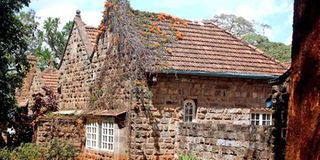Chiromo House that Ewart Grogan built

Chiromo House at the University of Nairobi in picture taken on Tuesday, July 09, 2019. PHOTO | DENNIS ONSONGO | NATION MEDIA GROUP
What you need to know:
While Grogan was in South Africa, he was influenced by Cecil Rhodes and as a result he believed that Africans were inferior and needed to be civilised.
Grogan made it a personal mission to ‘civilise’ Africans and to do this, he had two tunnels that could be used as a hidden escape routes beneath his house.
Within the tunnels are dungeons that were specifically made for the imprisonment of Africans after they had received a thorough beating from him.
Nairobi is a city endowed with rich history and a myriad of symbols and secrets. Located in the University of Nairobi’s Chiromo Campus, Chiromo House is a testament that the city’s secrets run deep below the surface.
ESCAPE ROUTES
The building’s original owner, Ewart Grogan, was an eccentric man who set records for what one can do for love. In order to prove himself worthy of Gertrude Watt’s hand in marriage, Ewart walked from Cape Town to Cairo, a journey he almost paid for with his life.
Surprisingly victorious in the trek, he returned to Nairobi, a place he had described as a ‘tin shack’ when he passed through it in 1899. He then purchased 113 acres bordering rivers Nairobi and Kirichwa and enlisted a London Architect, H.O. Graswell and local Indian contractors to build him a house in 1905.
He aptly named the house Chiromo after a village in Malawi where he was attacked by hostile tribesmen and lost all his belonging. This may have served to reverse his fortunes as he later amassed a lot of wealth.
It turns out that Chiromo House was no ordinary family house. While Grogan was in South Africa, he was influenced by Cecil Rhodes and as a result he believed that Africans were inferior and needed to be civilised.
Grogan made it a personal mission to ‘civilise’ Africans and to do this, he had two tunnels that could be used as a hidden escape routes beneath his house. Within the tunnels are dungeons that were specifically made for the imprisonment of Africans after they had received a thorough beating from him.
The house was also used by the then Commissioner Sir James Sadler as Grogan was an itinerant adventurer. Important cabinet meetings were held in the building’s conference room and former US President Theodore Roosevelt was at one time a guest in the house.
MASONIC SYMBOLS
In 1926, the house was sold to William McMillan, who lived there with his wife Lucie. Being influential at the time, they had the railway line, which was passing near the house, diverted to pass through Kibera.
Lucie had complained of being disturbed by the passing trains.
The house later served as a command centre during the emergency period before Grogan donated it to the government in 1958.
In 1964, the house was leased to British Institute East Africa who used the building until 1983. Currently, the building that was gazetted as a National Monument houses the Institute of African Studies of the University of Nairobi.
Surprisingly, the building has never been vandalised even after being abandoned and being used as a dumping site for several years.
The building with Masonic symbols such as the occult’s evil eye and two feline idols brought by Macmillan from West Africa has every indication that it was a Masonic Templar lodge.
The numerous Masonic symbols are believed to bring mystic powers to the house — something that is attributed to it not being vandalised in the 114 years it has been up.





